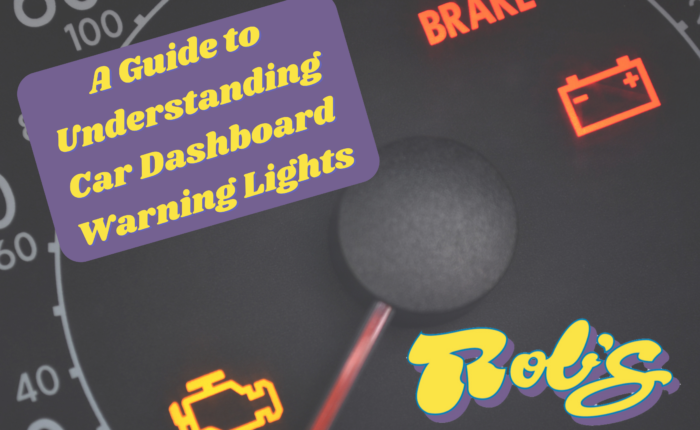A Guide to Understanding Car Dashboard Warning Lights
July 31, 2024


Dashboard warning lights are crucial for maintaining your vehicle’s health and ensuring your safety on the road. Each symbol on the dashboard provides specific information about the car’s current state, helping drivers to quickly identify and address issues. Here is a detailed explanation of some of the most common dashboard warning lights:
1. Brake System Warning Light
- Appearance: Typically a red light that may look like a circle with an exclamation point inside or the word “BRAKE.”
- Meaning: This light can indicate several issues, such as low brake fluid, engaged parking brake, or problems with the brake system itself, including the ABS (Anti-lock Braking System). If this light is on, it’s crucial to check the brake fluid level and ensure the parking brake is fully released. Continuing to drive with this light on can be dangerous, so it’s advisable to have the brakes inspected by a professional as soon as possible.
2. Check Engine Light (CEL)
- Appearance: An orange light often shaped like an engine or sometimes displaying the words “CHECK ENGINE.”
- Meaning: The check engine light can indicate a wide range of issues, from a loose gas cap to more severe problems like a failing catalytic converter. When this light comes on, it’s essential to get a diagnostic test to pinpoint the exact cause. Ignoring this warning could lead to more significant and costly repairs down the line.
3. Battery/Charging System Warning Light
- Appearance: Usually a red battery icon.
- Meaning: This light signals a problem with the vehicle’s charging system. Common issues include a faulty alternator, battery, or loose connections. It’s important to check the battery terminals and alternator belt. Driving with this light on can result in a dead battery and the car stalling, so immediate attention is required.
4. Oil Pressure Warning Light
- Appearance: An oil can symbol.
- Meaning: This light indicates that the oil pressure is too low, which can cause significant engine damage. Check the oil level immediately and add oil if necessary. If the light remains on, it’s best to have the vehicle inspected by a mechanic to avoid engine damage.
5. Coolant Temperature Warning Light
- Appearance: A thermometer symbol or a thermometer inside a liquid.
- Meaning: This light warns that the engine coolant temperature is too high, indicating the engine is overheating. Check the coolant level and look for leaks. If the coolant level is sufficient and the engine is still overheating, it may be necessary to visit a service center to prevent severe engine damage.
6. Tire Pressure Monitoring System (TPMS) Light
- Appearance: An exclamation point inside a horseshoe or a side view of a car with arrows pointing to the tires.
- Meaning: This light alerts you to a potential issue with your tire pressure. One or more tires may be underinflated. It’s crucial to check the tire pressure and inflate the tires to the recommended levels. Some vehicles can show which tire is underinflated and the specific pressure.
7. Traction Control or ESP (Electronic Stability Program) Light
- Appearance: A car with squiggly lines behind it.
- Meaning: This light indicates that the traction control or electronic stability system is active or has detected a problem. If the light flashes, the system is working to maintain traction. If it stays on, there may be an issue with the system that requires professional diagnosis.
8. Airbag Warning Light
- Appearance: A profile of a seated person with a circle (airbag) in front of them.
- Meaning: This light signifies a problem with the airbag system. It could mean that the airbags won’t deploy in an accident or could deploy unexpectedly. Given the critical safety role of airbags, it’s vital to have this issue addressed immediately.
9. Service Vehicle Soon Light
- Appearance: Usually a wrench or the words “SERVICE VEHICLE SOON.”
- Meaning: This light indicates a minor problem with the vehicle, often related to non-emission components such as lighting, chassis, or other electrical systems controlled by the Body Control Module (BCM). It’s not an immediate emergency, but the vehicle should be serviced soon to prevent further issues.
By understanding these warning lights and responding promptly, you can ensure your vehicle remains in good condition and safe to drive. For any warning light that remains on or blinks persistently, it’s best to consult with a professional mechanic, like those at Rob’s Automotive, to diagnose and fix the issue properly.
Contact Rob’s Automotive Today!
Rob’s Automotive & Collision is the region’s premier provider of all types of vehicle repair. Contact us today to schedule an appointment if one of your car’s warning lights is on.
And don’t forget! We’re certified by 24 major auto manufacturers and offer the best auto repair services in Bucks County, and the surrounding area. We also provide towing services for both cars and trucks. When you partner with us for your car care needs, you’ll always be taken care of!
